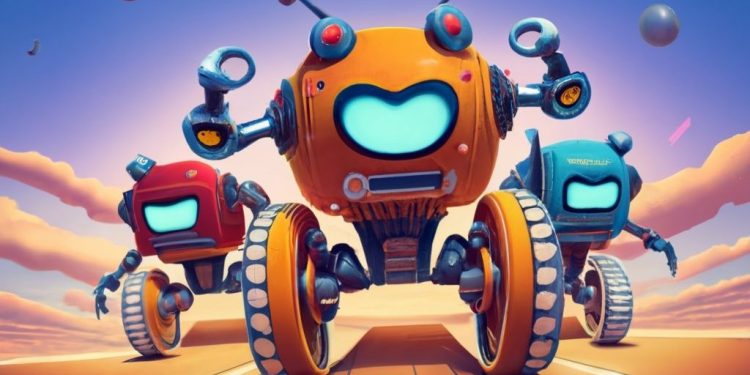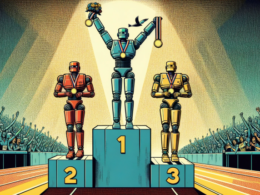When OpenAI launched ChatGPT a year ago today, the idea of an AI-driven personal assistant was new to much of the world. We all had seen chatbots capable of providing pre-programmed responses, but nobody thought they could have an actual conversational companion, one that could talk about anything and everything and help with all sorts of time-consuming tasks — be it preparing a travel itinerary, providing insights into complex subjects or writing long-form articles.
Fast forward to the present: despite all the company drama – from Italy’s short-lived ban to Sam Altman’s ouster and triumphant return, ChatGPT continues to be the go-to AI assistant for millions of internet-connected users. It’s present on the web and mobile devices, helping with various tasks and witnessing engagement on the scale of billions. According to SimilarWeb, in October 2023 alone, ChatGPT saw nearly 1.7 billion visits across mobile and web, with 193 million unique visitors and each visit lasting for about 8 minutes. To put into perspective, this is way more than the engagement witnessed by popular services on the internet, including Zoom (214M visits) and Google Meet (59M visits).
The Impact on the AI Ecosystem
But, beyond bringing conversational AI into the lives of millions in a matter of months, ChatGPT has also managed to catalyze the broader AI ecosystem. Soon after its launch, generative AI was the talking point for all, leading to the launch of dozens of consumer-facing offerings for producing text, music, video, and code. For chat and code, many of these offerings — like Github Copilot and Perplexity AI — leveraged fine-tuned versions of the GPT series of models that power ChatGPT. Several enterprises and startups also tapped the OpenAI APIs for internal business applications and creating custom GPTs for granular tasks like data analysis.
“In this race to jump on the AI bandwagon, many startups and tech giants also developed their own proprietary large language models (LLM) and came out with equally well-performing general-purpose chatbots that could understand, reason and respond to user prompts.”
Yes, they might not be as popular as ChatGPT yet, but they sure have democratized the space, making sure the OpenAI assistant is not the only of its kind.
Rivals in the Chatbot Market
First to the scene after OpenAI were Anthropic and Google. Mere months after ChatGPT’s launch, both companies debuted their respective conversational assistants: Claude and Bard. Anthropic, which was founded in 2021 by ex-OpenAI employees, focuses heavily on safety and ethics and has trained its assistant as a “constitutional AI,” where it follows certain sets of rules and improves with automated feedback. Bard, on the other hand, has been built on the Pathways Language Model 2 and works around Google search, using access to the internet and natural language processing to provide answers to queries with detailed context and sources. They both are seen as the biggest rivals of ChatGPT.
“Following Claude and Bard’s arrival, other interesting chatbots also started cropping up, including a year-old Inflection AI’s Pi assistant, which is designed to be more personal and colloquial than rivals, and Corhere’s enterprise-centric Coral.”
Of course, we can’t forget about Meta Platforms’ Llama 2 model — which has sparked a wave of development and fine-tuned variants due to the fact that it is open source. Most recently, six-month-old Reka debuted Yasa-1, which leverages a single unified model to understand words, images, audio, and short videos, and Elon Musk’s xAI announced Grok, which comes with a touch of humor and sarcasm and uses real-time X data to provide the most recent information.
Notably, while all these assistants have been designed to help users with tasks ranging from general search and text summarization to writing, one must always keep in mind that they are continuously evolving. The capabilities and limitations they have today may not remain as is a few months later.
“The gap between these players is expected to reduce, further pushing the bar on AI.”
After all, when ChatGPT launched a year ago, it was a text-based assistant. Today, it supports voice commands and images as inputs and even has its own voice to reply like Alexa.
In addition to the big ones mentioned above, several market-specific AI assistants have also been developed — tailored to different industries, audiences, languages and more distinct uses. This includes South Korean internet giant Naver’s HyperClovaX as well as China’s famous Ernie and recently-introduced DeepSeek chatbots, as well as Poro and Nucleus, the latter designed for the agricultural business. India’s Reliance Industries has also moved to launch a generative AI assistant designed for the country’s diverse dialects and has secured Nvidia’s computing infrastructure for the job.
“With so many players already working to deliver on the promise of conversational AI and many more moving towards launch, it is safe to say that the AI race is far from over. The global conversational AI market is expected to grow nearly 24% in the coming years and surpass $86 billion by 2032.”
Will LLMs become commoditized, with every industry or potentially even every company having their own specific one? Time will tell: check back here in a year.










